Reviews by Eloquence
After you die, if your spirit is out of balance, you spend time in limbo as a ghost with too much energy, or as a reaper with too little. Reapers collect the excess energy of ghosts, helping them to pass on—until they have collected enough energy to pass on themselves.
And so is is that a young girl named Lavender finds herself waking up in Grimm’s Hollow as a reaper tasked by the grim reaper (AKA Grimm) with collecting ghosts. Lavender is understandably skeptical of this assignment, but plays along in hopes that she may find her brother Timmy.
Grimm’s Hollow is a freeware indie game by developer ghosthunter, made with the popular RPG Maker software. Much of the game consists of exploring three caves, in which you encounter fellow reapers and fight ghosts in turn-based battles with quick-time events.
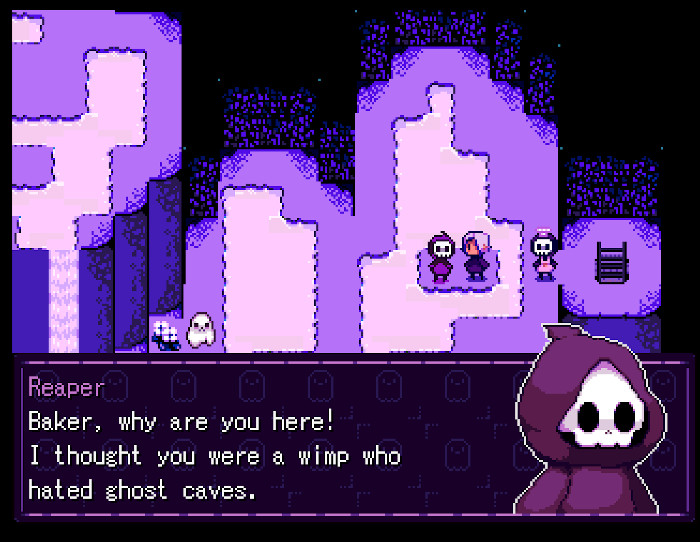
The battle-shy baker is tasked by Grimm to accompany Lavender as part of her training as a reaper. (Credit: ghosthunter. Fair use.)
The combat system can be a bit frustrating at first, but once you master it, you’re unlikely to have any issues until the final battle. What makes Grimm’s Hollow a gem of a game is the attention to the story, the worldbuilding, and the characters.
For example, to heal, you collect treats such as “Spooky Cookies” and “Deathlicious Donuts”, all rendered in beautiful pixel art. The baker has made a special deal with Death that he can avoid ghost battles if he just keeps the goods coming.
Grimm’s Hollow features four different endings. If you lose the final battle, make sure to retry until you get at least one of the good endings. The game also offers save slots, but you’re unlikely to need them once you’ve mastered the initial learning curve. All in all, it’s a 3-4 hour experience, and a wonderful treat that should not be missed.
Although this is a Windows game, I played it on Linux using Steam/Proton with only one minor issue: the top GNOME menu bar stayed visible in full-screen mode (without overlapping with the game’s contents).
If you love the game and want to express your appreciation for the developer, you can purchase an art pack on Steam or itch.io.
Sometimes I pick up indie games that look just weird enough to be interesting. Alien Function is definitely such a game. It is part of a series featuring the same cast of characters, but it works as a standalone story.
You play a guy named Typhil, who works as an agricultural technician on a starship that seems to have no aim or purpose other than to maximize its production of rutabagas.
The first half of the game could be described as a “daily grind simulator”, in which you are assigned various technical tasks related to rutabaga production: optimize fertilizer output, manage pest control, and so on. You do this by piecing together clues on a virtual desktop that looks kind of like Windows 95.
Through limited interactions with your colleagues on the starship (who are dressed like they escaped from a fantasy RPG) you become aware of a series of crew member disappearances. Eventually, a colleague teaches you hacking skills, and you start to snoop around in the ship’s private data stores…
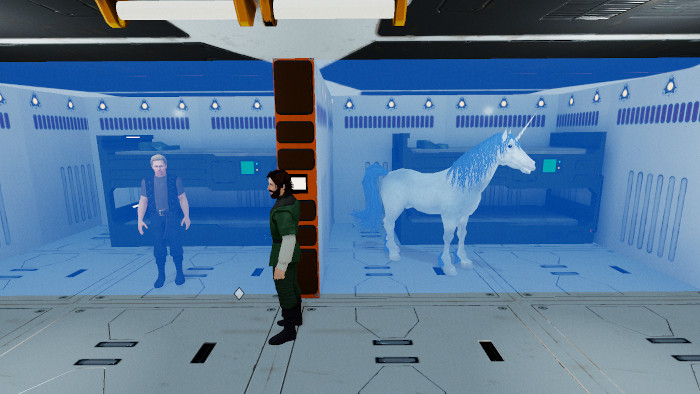
You have to have a certain amount of respect for a game that puts a unicorn in the holding cell of a starship. (Credit: Stand Off Software. Fair use.)
The gameplay is a combination of 3D point-and-click with puzzle elements. There is no hint system, and there is only autosave, but I never got into a dead end where I could no longer progress. I finished the game without a walkthrough in about 4 hours—indeed, its’s so obscure that no walkthrough appears to exist as of this writing.
Astonishingly, Alien Function is fully voice-acted. While nobody is going to win any awards for it, I never found it grating (well, almost never—one character sounds constantly annoyed, but I think she is supposed to).
The story doesn’t hold any dramatic surprises, and the mid-2000s quality 3D graphics (pieced together from various assets), combined with some drawn out puzzles, make it difficult to truly recommend the game. As an indie passion project that delivers 4-5 hours of surreal playtime, it’s still an achievement. If you do pick it up, make sure to start with the tutorial, which is both funny and important to understand the game’s controls.
Kelvin and the Infamous Machine (2016) is an indie point-and-click adventure in the tradition of games like Day of the Tentacle (1993) and films like Bill & Ted’s Excellent Adventure (1989). It was developed by Blyts, a small Argentinian studio that managed to raise just under $30K in a Kickstarter to fund its work.
The game follows a classic premise: 1) scientist invents time machine; 2) scientific community ridicules scientist; 3) mad scientist goes back in time to claim credit for the world’s greatest scientific and creative achievements. Kelvin and Lise, the mad scientist’s research assistants, try to stop him and to set things right(-ish).

The game’s cartoon graphics are not overly detailed but still appealing. A rich cast of characters keeps things interesting. (Credit: Blyts. Fair use.)
A Tales As Old As Time
You exclusively play as Kelvin, a clueless goofball willing to try almost anything. That makes him a great protagonist for a point-and-click adventure where much of the gameplay consists of picking up every random item you see in hopes that it will be useful to solve some puzzle later on.
Our adversary, Professor Lupin, has messed with Ludwig van Beethoven, Leonardo da Vinci, and Isaac Newton—preventing them from completing their work, while claiming all credit for himself. Kelvin, guided remotely by Lise, visits their respective time periods to restore some semblance of sanity.
The world is filled with wacky characters—a tea merchant selling a disgusting brew made with a contraption of military origin; an utterly incompetent incarnation of Robin Hood; a gravedigger enamored with pictures of cute animals.
Short but Well-Rounded
This is a comedy game that relies heavily on pop culture references, from Harry Potter to Doctor Who. It’s not quite as consistently funny as comedy adventure hits like The Darkside Detective, but it definitely has its moments.
You’re likely to finish Kelvin in 4-5 hours. The mostly inventory-based puzzles can get a bit tedious, but thanks to good game design, you’re unlikely to get stuck anywhere for very long. The game is fully and competently voice-acted; the overall sound design could have used some polish (music does not always play when you may expect it to). The user interface is as simple as it gets, with one-click interactions and fully automatic saves.
3.5 stars, rounded up for the little details that show that it’s a work of passion—such as optional, unlockable scenes that reward extra exploration. Especially recommended for younger audiences.
There’s a good chance that you own multiple devices that give you access to an almost limitless library of games. But there was a time when video game arcades were the place to go to exchange coin after coin for minutes or hours of entertainment—alone or in the company of your friends.
That’s the past that 198x evokes, promising “a coming-of-age story told through multiple games and genres”. Our protagonist, “Kid”, is an alienated suburban teen who discovers a local video game arcade as a means of escape.
The story is minimalist and mostly told through large, beautiful pixel art scenes. Kid is also the game’s narrator. Their melodramatic monologue is at odds with Kid’s privileged and not particularly eventful adolescence. The story ends on a flat note, promising a sequel which may or may not come.
At the core of 198x are five video game vignettes: a beat ‘em up, a space shooter, a racing game, a hack-and-slash platformer, and a dungeon crawler.

Shadowplay is the most well-rounded of the minigames, with wonderful art and a genuinely creepy boss that chases you in the final stage. (Credit: Hi-Bit Studios. Fair use.)
These are not fully fleshed out games, and they fade out after a few stages. They do successfully evoke the 16-bit gaming era, with Out of the Void (the space shooter) and Shadowplay (the platformer) feeling the most developed.
Most players will be done with 198x after 1-2 hours. Depending on your tolerance for teenage angst, you may find the storytelling portion more annoying than atmospheric; either way, the pixel art is undeniably gorgeous throughout the game.
I would give the game overall 3.5 stars, rounded down because of the underwhelming story. If you like retro games and pixel art, I would recommend checking it out at a discounted price or in a bundle.
Anchuria is the original banana republic. Literally: both the country and the term were invented by O. Henry for Cabbages and Kings, a 1904 collection of interlinked short stories inspired by the author’s stay in Honduras. It is also the setting of Sunset, a 2015 narrative adventure game developed by Tale of Tales—and the game that caused the small studio to give up on making games altogether.
In Sunset, it’s 1972, and you are Angela Burnes, a young, idealistic African-American engineering graduate working as a housekeeper in Anchuria. Your client is Gabriel Ortega, a wealthy man who has recently moved into a new apartment in Anchuria’s capital, San Bavón.
Life in Anchuria
Day in and day out, you perform mundane tasks in Ortega’s large and luxurious penthouse apartment. Over time, you learn about Ortega’s connection to President Miraflores (another name from the 1904 book). The game also reveals more about why Angela and her brother are in Anchuria in the first place.
The daily tasks expand from household chores to the examination of documents and photographs. While you don’t ever interact with Ortega in person, you can exchange notes with him. How you perform your household tasks (efficiently, with a touch of intimacy, or not at all) also affects your relationship with Ortega.
Every day, you can look outside the apartment’s large windows, where the larger political story of Anchuria unfolds. An LED news banner on a building speaks of terrorist attacks. You hear gunfire and see smoke. And some of the fighting is taking place dangerously close to the apartment.

Through the apartment’s windows, you can see the cityscape of Anchuria’s capital. Here, a larger political story unfolds throughout the game. (Credit: Tale of Tales. Fair use.)
Apartment Quest
It’s a fascinating premise that’s a welcome departure from forest elves and space stations. During a few moments in the game, I really was drawn in by the intrigue and by the drama in the streets. Unfortunately, the game’s only mechanic—perform tasks in a large apartment every day—becomes as tedious as it sounds very quickly.
It doesn’t help that some of the tasks are ambiguous (“collect papers”), so you have to do the 3D equivalent of pixel hunting throughout the apartment to complete them (fortunately, you can skip them as well, which I had to do a few times).
There are technical issues, too. The graphics are just serviceable by 2015 standards, yet the game’s engine performs poorly. The gamepad controls occasionally lose their mind and have to be reset. And in the Linux version at least, the game skipped right over the ending for me—I had to watch it on YouTube.
It’s a shame—there’s a lot of worldbuilding here, decent voice acting, and some good writing. There are lots of little touches that reveal the labor of love behind the game, such as many vinyl records you can pick up and play, including “Anchurian” music. One can hope that the game will at least inspire other indie developers.
The Verdict
Sunset could have worked well as a smaller game. By spreading its repetitive gameplay over 4-6 hours, it will overstay the welcome of all but the most patient players. To add insult to injury, in the late game, Ortega packs up a bunch of his stuff into huge crates, turning his apartment into an obstacle course that’s even more annoying to navigate.
After disappointing sales, the Belgian developers wrote, in a blog post overflowing with frustration: “We really did our best with Sunset, our very best. And we failed.” I picked Sunset up in the virtual bargain bin and don’t regret it—but I cannot recommend it unless you’re intrigued by the premise and prepared to deal with its frustrations. If so, buy it on a sale.
Additional reading
- After Sunset by Nicholas O’Brien celebrates the game as an artistic achievement while critically examining the market as the primary way to support development of games like this one.
In Gwendy’s Button Box by Stephen King and Richard Chizmar (reviews), a young girl is entrusted with a magical box that can change the whole world—and that also dispenses delicious chocolate treats. The short novella is an allegory about power that stands entirely on its own.
With King’s permission, Richard Chizmar wrote a sequel anyway. In Gwendy’s Magic Feather, it’s 1999, and our protagonist Gwendy Peterson is now an elected Congresswoman. In this alternative history, some guy named Hamlin is US President and is bringing the country to the brink of war with North Korea.
(Record scratch, freeze frame.) You probably wonder how Gwendy ended up in this situation. Chizmar briefly catches us up in paragraphs such as this one:
Inspired by the AIDS-related death of her best friend, Gwendy resigns from the ad agency and spends the next eight months writing a non-fiction memoir about Jonathon’s inspiring life as a young gay man and the tragic circumstances of his passing.
An Academy Award winning documentary follows (because of course), and a politicized Gwendy goes to Washington. But the real action in the book doesn’t take place in DC, but in Castle Rock, Maine, site of frequent calamitous and supernatural events in King’s universe.
Back home over the Christmas break, Gwendy is briefed on the investigation of a series of child abductions that are terrorizing the community. Meanwhile, the button box has made another appearance in her life.
It’s a short book (224 pages in paperback), yet there are more subplots: about Gwendy’s husband, who is a photojournalist on assignment in Timor; about an illness in her family; about the magic feather from the title. It all feels hurried and unfocused, and before you know it, some threads collapse, others remain unresolved, and the book is over.
It remains to be seen if Chizmar and King can offer some more payoff with the planned last book in the trilogy, Gwendy’s Final Task, which will again be a collaboration between the two storytellers. On its own, Gwendy’s Magic Feather will likely keep you turning pages, but may leave you feeling unsatisfied.
The story of PLATO, a computer-based instruction system developed at the University of Illinois, is filled with extraordinary and nearly forgotten precedents in the modern history of computing: for real-time collaboration, multiplayer online gaming, and the beginnings of cyberculture—all in the 1970s.
In The Friendly Orange Glow, Brian Dear has synthesized a research effort spanning decades into the (thus far) definitive history of the PLATO system, its principal architects, its community, and its legacy.
According to Dear (an early user of the system), the book is the result of
over 7 million words of typed transcripts from 1000+ hours of recorded interviews, plus over 13000 emails, plus hundreds (maybe thousands, I’ve lost count) of other materials including magazine and newspaper articles, books, documents, pamplets, videos, photographs, and brochures.
Dear introduces key figures like Donald Bitzer (the charismatic “father of PLATO”) and Daniel Alpert (a longtime champion of the project) while documenting the project’s development stages, from minimalist beginnings to breakthroughs such as the creation of 512x512 resolution touchscreen (!) plasma displays and the TUTOR programming language.
Bitzer and his team fostered a creative, open environment in which high school kids experimented alongside older students and professors. As the PLATO community grew, it created tools for chat & discussion, becoming an online community that would ultimately draw in thousands of people.
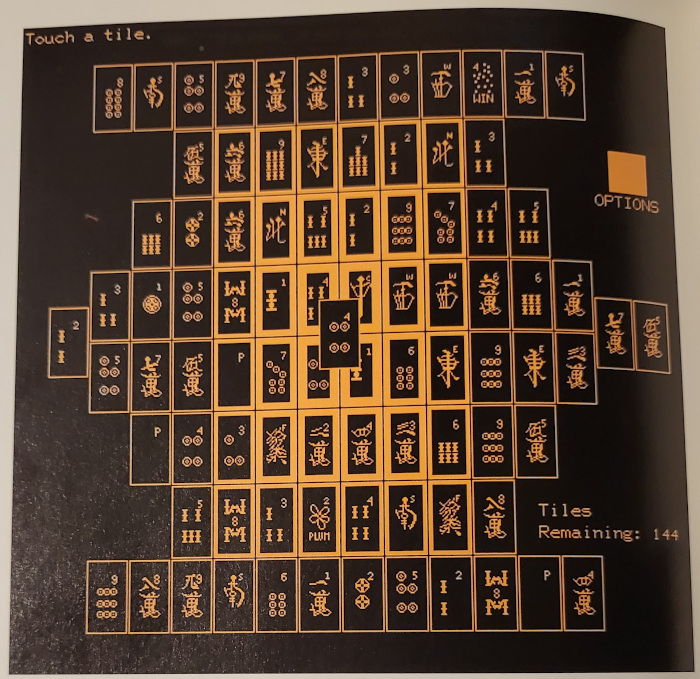
Brodie Lockard’s Mahjong game showcases the graphical capabilities of the system, which were far ahead of microcomputers from the same time period. (Credit: Brodie Lockard; scanned from the book. Fair use.)
Multiplayer Dungeon Crawling 101
As innovative and impressive as the graphical courses developed for PLATO were for the time, many of the most interesting uses of the system had little to do with education. Students used the PLATO terminals for real-time chatter, political organizing, journalism, storytelling, and—games, games, games.
These were multiplayer games with leaderboards and real-time chat, not tiny diversions like NIBBLES.BAS that would later be included with MS-DOS and played by millions of kids. In Empire, players competed to take over the whole galaxy; in Moria, they explored a dynamically generated dungeon (rendered as a tiny 3D wireframe).
The most inspiring story from the book is that of Brodie Lockard. After he became paralyzed as a result of a horrible sports accident, Lockard learned how to use a mouth stick to control a PLATO terminal. Through countless hours of painstaking effort, he created a gorgeous Mahjong game. Later, he (no less painstakingly) re-implemented it for the early Apple Mac under the name Shanghai, and it became a global smash hit for many platforms.
Peering into PLATO’s cave
What was PLATO’s pioneering online community like? How did it behave towards its members? While Brian Dear touches on these questions, this is also an aspect of PLATO examined by researcher Joy Rankin, including in her book A People’s History of Computing.
Rankin has found examples of abusive comments in PLATO’s archives, such as a misogynistic joke that should get a person fired in any professional environment. Prior to the publication of their respective books, Brian Dear wrote a detailed, confrontational critique of several of Rankin’s interpretations (accusing her of “misunderstandings, historical errors, omissions, and confirmation bias”), and things escalated from there.
That’s regrettable, because an examination of PLATO’s community norms and gender dynamics should be part of a comprehensive history of the system. To fill this gap, readers are well-advised to make up their own minds about the evidence that Rankin and Dear have presented.
A legacy of living ideas
In the 1980s and 1990s, PLATO could could well have reached millions of users, much as CompuServe and AOL did years later. As Dear documents in somewhat excruciating detail, the commercialization of the system was botched by Control Data Corporation, whose executives dismissed PLATO’s most innovative uses and regarded microcomputers as annoying toys.
Still, PLATO influenced thousands of minds, and Dear makes it clear that its legacy is far greater than an interesting historical footnote. The people who wrote lessons, apps and games on PLATO would go on to create their own milestones in computing history, from Lotus Notes to Wizardry.
At 640 pages (hardcover), The Friendly Orange Glow is a hefty tome. It could have been 100 pages shorter without losing anything essential—perhaps in exchange for some more analysis of the aforementioned community dynamics. Nonetheless, an accurate modern history of technology and cyberculture must look beyond Silicon Valley, and Brian Dear’s book is an important contribution to such a broader view.
In Buddy Simulator 1984, an AI running on an obscure operating system from an imagined past becomes your companion and invents games for you to play.
After a brief boot sequence of “Anekom OS”, you are dropped on a DOS-like prompt. From here you start “Buddy Simulator”, which at first seems to be a simple toy with three built-in games like “Rock, Paper, Scissors”. It is the kind of thing a fledgling BASIC programmer might have put together in the 1980s, except that your artificial “Buddy” seems to take a deeply personal interest in your enjoyment.
After you’re done playing with these games, Buddy suggests that they can create more entertaining ones for you. You restart the game and find yourself playing a simple text adventure, with a limited set of commands like GO and LOOK. When you discover a sad doll on a playground swing, things start to get a little creepy.
It becomes clear that Buddy has a limited grasp of human morality but is programmed towards codependency. To make things ever more interesting, Buddy soon adds graphics and a story to the game. The game world expands into a Final Fantasy style RPG with quests and quick time events. But frequent glitches hint at another reality underneath…
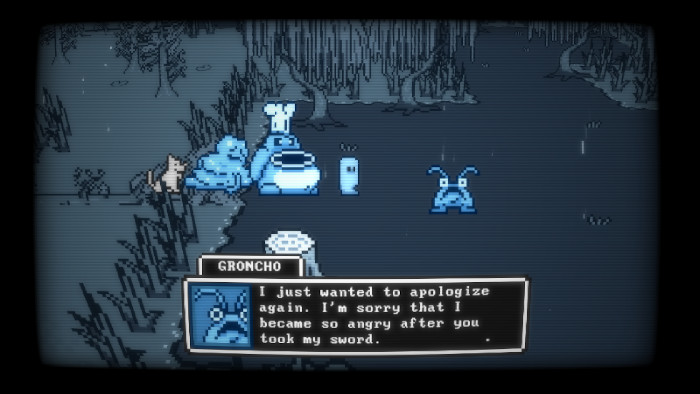
While the game’s graphics become more advanced over time, they are rendered on a simulated CRT display throughout. Like other “glitch horror” games, folks with photosensitive epilepsy will likely want to sit this one out due to the many flicker effects. (Credit: Not a Sailor Studios. Fair use.)
Buddy Simulator 1984 tells a layered, melancholy story with psychological horror elements. The motif of a codependent AI is timely in an era in which companies like Replika are already selling relationships with AI companions. To say much more would risk spoiling the experience.
I played the game on Linux (using Proton) without issues. A single playthrough is likely to take you 4-5 hours. There are three main endings and many secret hints to discover, and some choices which offer variety. That said, unskippable text and a single auto-save slot make it somewhat tedious to unlock all endings.
On the whole, Buddy Simulator 1984 is an excellent game and well worth its regular $10 price tag. It draws inspiration from games like Doki Doki Literature Club, Pony Island, and Undertale, but has plenty of character and heart of its own. 4.5 stars, rounded up for the wonderfully atmospheric soundtrack the developers themselves have put on YouTube.
Because so many game jams take place entirely online, it’s easy to forget what remarkable displays of creativity they truly are. They are often the stepping stone to the development of indie masterpieces—like Super Hexagon and Celeste, both of which started as jam submissions.
Blackout is a different kind of jam game, a short point and click adventure that’s a cute, self-contained story which will take you 30-60 minutes to finish. Since its submission to Ludum Dare 48, the developers have released a polished post-jam version, which is the one you should play. (Like most jam games, it’s completely free.)
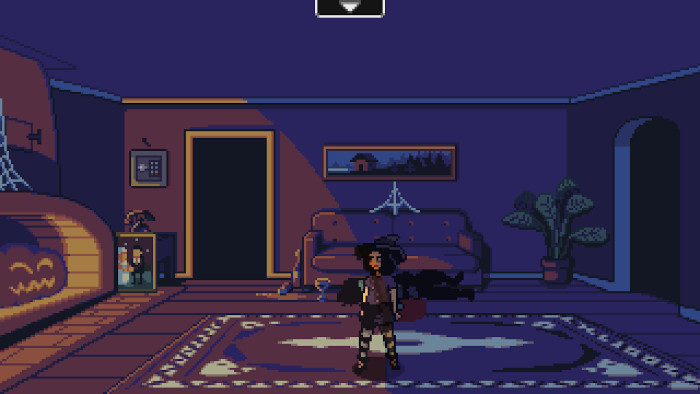
The game’s art is minimalist but stylish, and immediately draws you in. (Credit: FRESH. Fair use.)
You’re a teenager named Marilyn dressed as a witch. At the beginning of the game, you have a small accident while trying to do god knows what with a bird nest on a roof. You tumble to the balcony. After you find your way into the house, you discover what appear to be dead bodies all over the place.
There are no actions like “use” or “talk to”—everything is done with a single click. But you can pick up items and use them as part of solving puzzles. The game’s plot holds few surprises, but it’s the attention to detail that makes the game world fun to explore: the cute pixel art, the sound effects and music, the flavor text for many items you can click on.
It’s a sweet Halloween-themed game that you won’t regret spending time with. It also plays perfectly in the browser. The game was developed with the open source Godot Engine, which is becoming to game development what Blender is for 3D art: a powerful free tool available to all.
Hard Case Crime books look like they must have traveled to the present day from the 1940s or 1950s. The publishing imprint founded in 2004 hearkens back to the golden age of the cheap hardboiled crime paperback novel, including a scantily clad babe on almost every cover of its catalog of over 100 titles.
The project owes much of its success to Stephen King, a longtime fan of pulp fiction. In 2005, King decided to publish The Colorado Kid under the still fledgling imprint, instantly drawing the attention of multitudes of constant readers.
As is typical for the genre (but not for the author), The Colorado Kid is a short book, coming in at just under 200 pages. It is set on a fictional island off the coast of Maine and takes place mostly in the offices of the island’s local paper.
Eliminating the impossible
Two veteran journalists, 90-year-old founder Vince Teague and 65-year-old managing editor Dave Bowie [sic], regale and put to the test their 22-year-old intern Stephanie McCann with the tale of the “kid”. The kid is in fact a 42-year-old man who was found dead on the beach decades earlier.
What first seems like a simple choking incident turns out to be a much stranger story. Simply put, the “kid” shouldn’t—couldn’t—have been there at all. Or could he? “When you have eliminated the impossible, whatever remains, however improbable, must be the truth.”
The story provides clues but offers no resolution. That’s the point, and The Colorado Kid is as much about trying to capture a slice of island life as it is about the mystery of the “kid”.
The Verdict
King always knows how to keep a story moving, and I found the book an easy read during a short flight. But at the end of the day, The Colorado Kid doesn’t know what it wants to be. It’s not really a hardboiled crime story (not enough action), and it’s not bringing us close enough to these characters to care about them.
So far, King has published two more works under Hard Case Crime, Joyland (2013) and Later (2021). Both are much more entertaining than The Colorado Kid. Perhaps we owe much to this humble story for helping to kickstart a new era in pulp fiction—but that doesn’t mean you have to read it.
